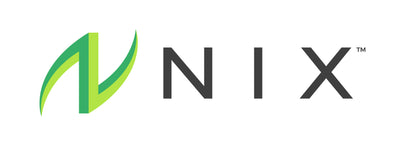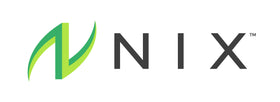written by Morgan Rosin
With rising attendance, new franchises, and expanding media deals, the National Women’s Soccer League (NWSL) is quickly becoming a global force in professional soccer - and the performance demands placed on players are higher than ever. With packed schedules, long travel days, and summer heat, hydration isn’t just about avoiding cramps—it’s a strategic pillar of performance, recovery, and longevity in the league.
From mental clarity to muscle function, hydration is deeply personal, especially for female athletes, whose physiology, sweat response, and hormonal cycles introduce unique variables. Through collaboration with three professional teams, we’ll examine the vital role hydration plays in women’s pro soccer and explore personalized strategies that go beyond generic guidelines.
About the National Women's Soccer League (NWSL)
The NWSL is the premier professional women’s soccer league in the United States. Founded in 2012, with the first game played in 2013, the league was established following the collapse of two earlier women’s leagues, the Women's Professional Soccer (WPS) and the Women's United Soccer Association (WUSA). The league began with eight teams.
More than a decade later, the NWSL has grown into a globally respected, commercially viable league drawing top talent from around the globe. It continues to evolve rapidly, with surges in attendance, TV ratings, investment, and fan engagement.
As of 2025, the NWSL includes 14 clubs across the United States, spanning coast to coast and reflecting a wide range of environmental conditions:
- East Coast & Southeast:
Gotham FC (New York/ New Jersey), Washington Spirit, Orlando Pride, North Carolina Courage
- Midwest & South:
Chicago Stars, Racing Louisville FC, Houston Dash, Kansas City Current
- West Coast & Mountain Region:
Angel City FC (Los Angeles), San Diego Wave FC, Portland Thorns FC, Seattle Reign FC, Utah Royals FC, Bay FC (San Francisco Bay Area)
Expansion teams for 2026 include Denver Summit FC and Boston Legacy FC.
This geographic spread creates significant travel demands and exposes players to hot, humid, dry, and elevated climates—each with distinct hydration challenges.
Elevating Women's Soccer Training
Three teams within the NWSL have utilized Nix Pro during training to help develop a baseline and hydration profile for their female players. Across all teams, Nix Hydration Biosensors were deployed on a wide range of players—spanning every position from forwards to goalkeepers. Data was collected exclusively during training sessions, not matches.
For strength and conditioning coaches, position coaches, and sports nutritionists, integrating this cutting-edge technology was essential for accurately tracking fluid and electrolyte losses by player—enabling the development of personalized hydration strategies to keep athletes game-day ready.

Sweat Losses by Position
Data was collected from female professional soccer players, with the majority of training sessions held outdoors in ambient temperatures between 66°F and 86°F. Notably, 80% of these sessions occurred under conditions with a Nix Index of 80 or higher, indicating elevated heat stress. On average, players lost 25.1 ounces of fluid and 945 milligrams of electrolytes per hour.
While overall sweat losses do not differ markedly by position, a player’s role, physical demands, and training regimen remain highly individualized. The range of fluid loss within a single position can be substantial. Among defenders, for instance, one athlete recorded losses as low as 13.6 ounces per hour, while another reached 41 ounces per hour—a difference of over 27 ounces, equivalent to more than 1.5 pounds of fluid. Looking at averages alone is a big mistake. Every player’s hydration plan has to be individualized.
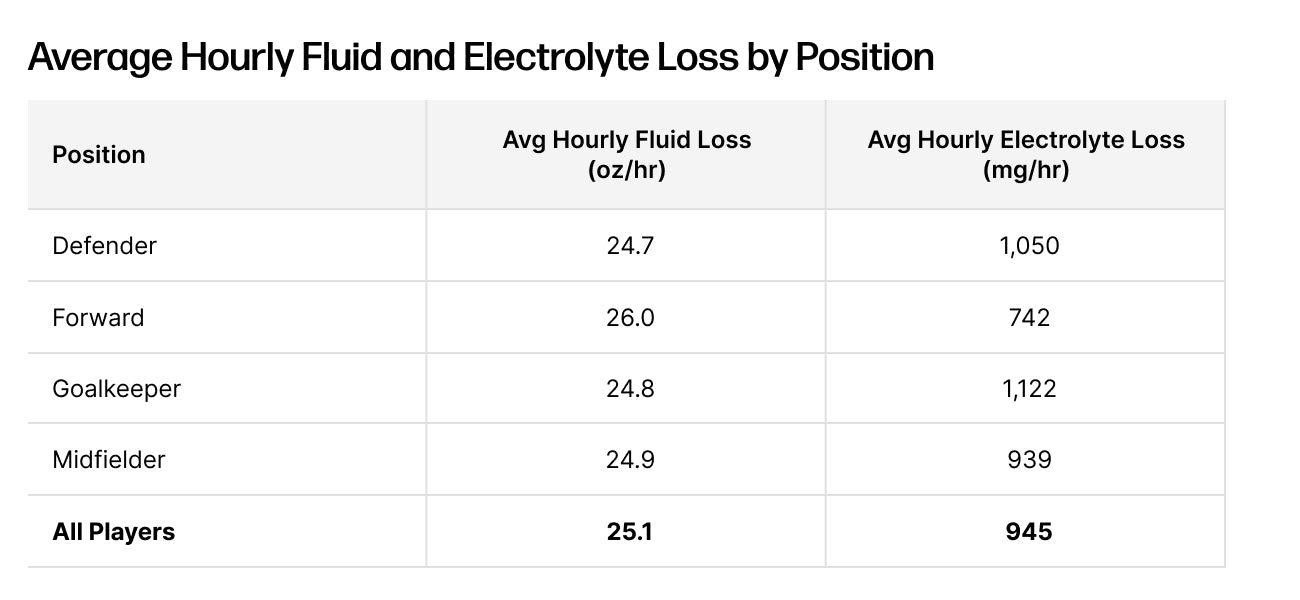
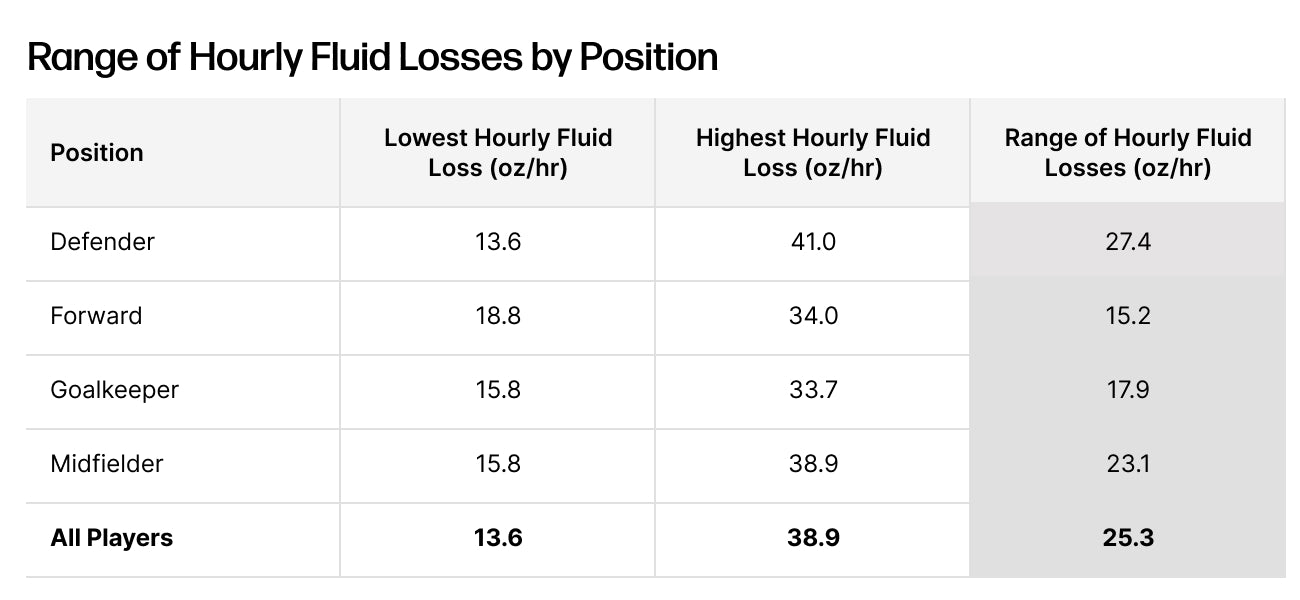
Cannot rely on averages alone. Every player sweats differently, every plan must be individualized.
Further analysis of the data reveals a wide spectrum of both fluid and electrolyte losses among teammates. For instance, Defender 2 recorded losses of 37.5 ounces of fluid and 2,063 milligrams of electrolytes per hour, resulting in a sweat composition of 55 mg/oz—closely aligned with the formulation of Liquid I.V. By contrast, Defender 14 lost only 13.8 ounces of fluid and 405 milligrams of electrolytes per hour, yielding a much lower sweat composition of 29 mg/oz. This athlete’s profile is more closely matched to a beverage like Nuun. While teams typically have a limited selection of electrolyte drinks available, data of this kind enables performance staff and nutritionists to adjust the preparation of bottles on hand, tailoring hydration strategies to the unique needs of each player.
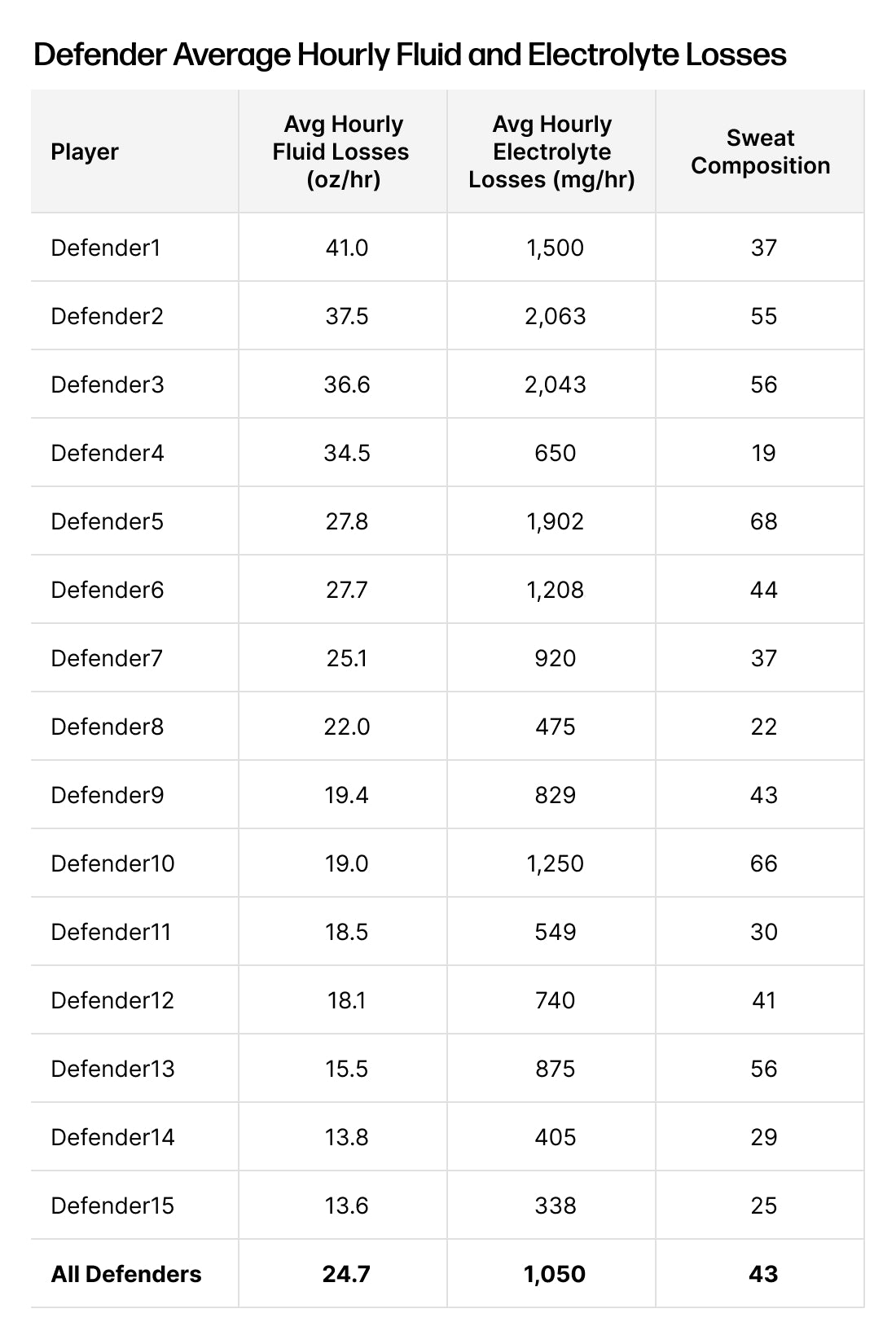
Performance Impairment for Soccer Players
Players often cover five to seven miles per match, alternating between steady aerobic movement and explosive sprints, pressing, cutting, and tackling—activities that place a substantial physiological load on the body.
Long travel schedules, short turnarounds, and varying climates further challenge their thermoregulation and hydration systems
Dehydration, including electrolyte imbalances, can cause performance impairments with just 2% loss in body mass. Within the collected data set, roughly 50% of training sessions reached or exceeded this critical threshold. Without adequate hydration, athletes risk muscle cramps, cognitive dysfunction, and reduced on-field performance.
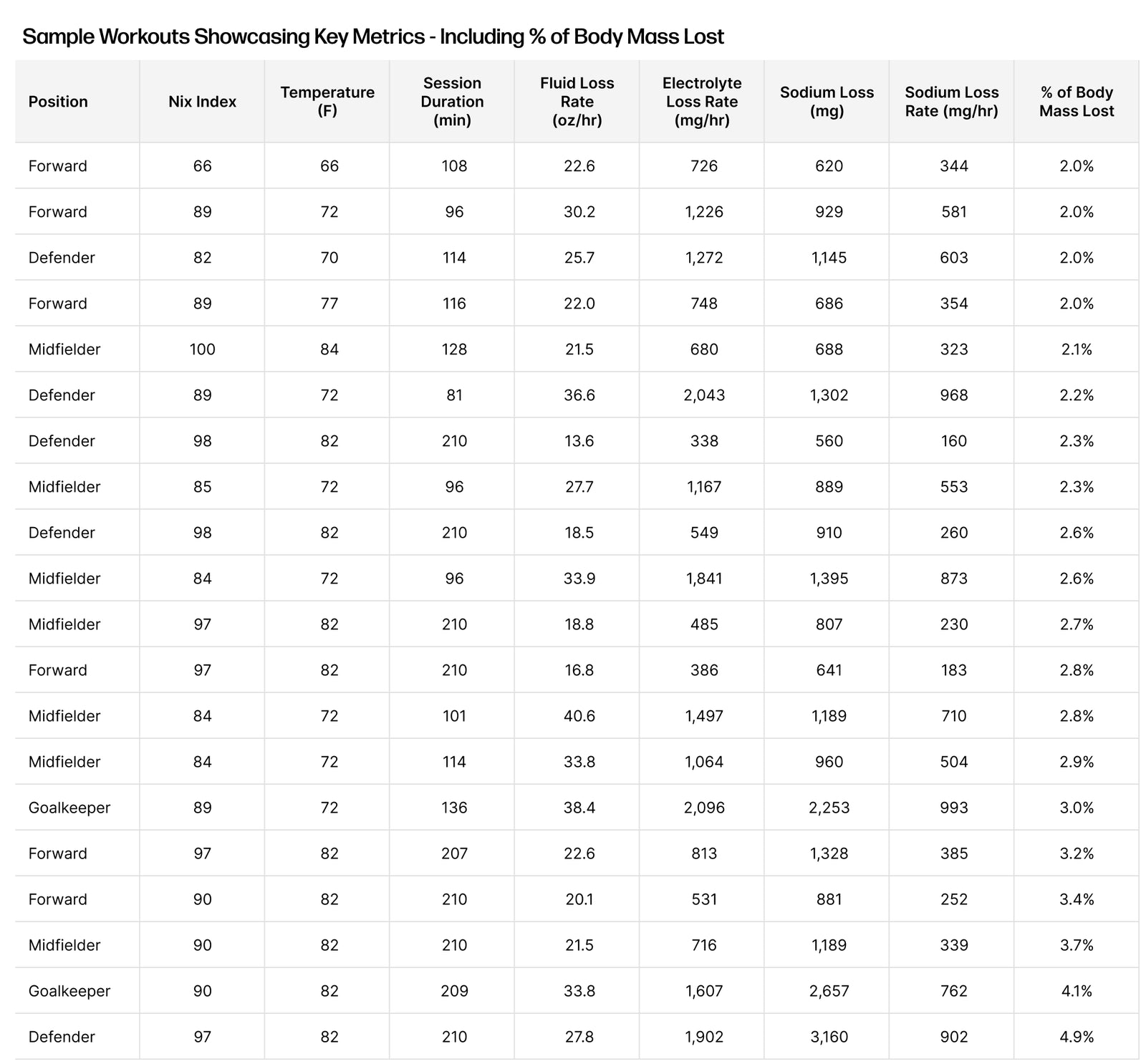
"Providing appropriate hydration recommendations for our athletes has been pivotal, especially as we headed into the warmer months of our season. Being able to evaluate our players’ sweat concentration and sweat rate using Nix has become an essential tool for me as a clinician” said Angela Bruzina, Team Dietician, Bay FC.
Position-Specific Hydration Needs and Concerns
Each position on the field has different considerations when evaluating hydration needs.
Goalkeepers: Even mild dehydration can impair decision-making which is crucial when a split-second reaction determines a save or a goal.
Defenders: Often experience moderate to high sweat loss and should prioritize fluid and electrolyte replacement to help prevent cramping during sustained defensive efforts.
Midfielders: Typically have the highest fluid and electrolyte losses due to their constant movement. Personalized hydration strategies are essential, with an emphasis on pre-hydration and refueling to avoid second-half performance dips.
Forwards: Sweat rates vary by role. Outside wings often cover more ground than strikers and may require greater fluid intake to maintain peak performance.
Practical Application for Professional Soccer Players
Today’s NWSL demands everything—endurance, speed, resilience, and mental acuity—and hydration is a key driver of sustained performance. A one-size-fits-all approach simply doesn’t meet the needs of elite athletes. Sweat rates and electrolyte losses vary significantly from player to player, making individualized strategies essential. Training session data provides a crucial baseline, enabling tailored hydration plans that support each athlete on game day and beyond.
The modern NWSL player has speed, mental toughness, and physical durability—but no one is immune to the effects of dehydration. As training and match loads increase, the smartest athletes are leaning into data-driven, individual-specific hydration strategies - not a one-size-fits-all approach. Data from training sessions is critical in providing a baseline, allowing personalized hydration strategies to be crafted for game day. For Bruzina, “Nix seamlessly integrates into training sessions and accurately captures information I need to individualize plans for my athletes.”
This isn’t just about health—it’s about maintaining performance at the highest level.
Additional Reader Notes
Do you have a hydration topic that you want to see us cover? Send us a note to info@nixbiosensors.com and we’ll add it to our list of upcoming article content.
Data for this article was compiled based athlete gender, position, workout length and activity type (soccer) for workouts collected through Nix's group monitoring app.
